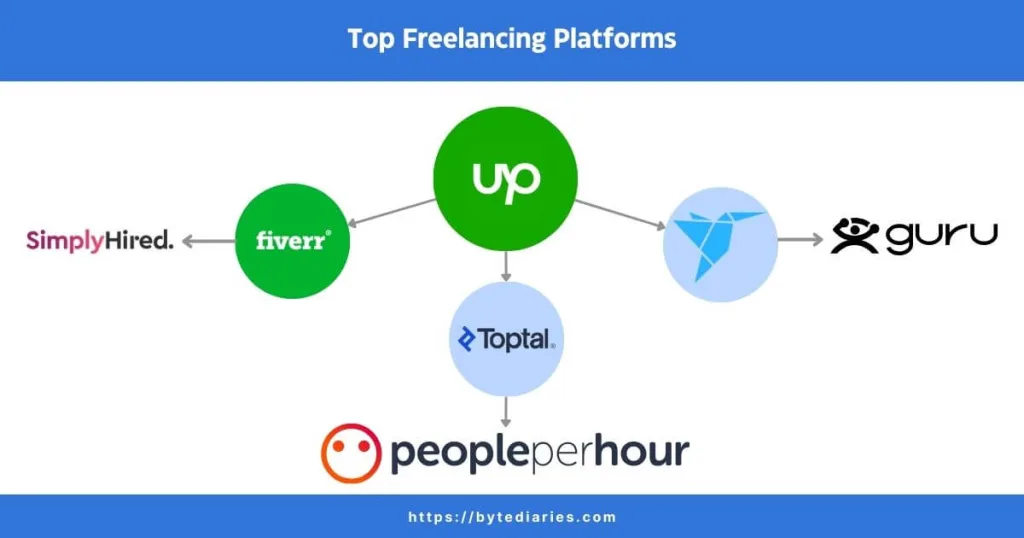Freelancing offers unparalleled flexibility and opportunities, but choosing the right platform is crucial to a successful career. Whether you’re just starting or already experienced, the right freelancing platform can help you find clients, secure projects, and grow your career. In this blog, we’ll explore the top 5 freelancing platforms, detailing their features, pros, and cons, to help you decide which suits your needs best.
Table of Content

1. Upwork: The All-Rounder
Best for: Freelancers in various fields, from writing to web development.
Upwork is one of the largest freelancing platforms, offering opportunities for both beginners and professionals. With its vast marketplace, you can find clients in virtually every industry.
Features:
- Easy-to-use interface for finding jobs and submitting proposals.
- Escrow payment system for secure transactions.
- Ability to build long-term relationships with clients.
Pros:
- Wide variety of job categories.
- Transparent payment protection.
- Excellent for long-term contracts.
Cons:
- High competition, especially for beginners.
- Service fees (5-20%) can reduce earnings.
Pro Tip: Optimize your profile with a niche focus to stand out. For example, instead of “Web Developer,” brand yourself as a “React.js Specialist.”
For more insights, check out our guide on How to Win Upwork Jobs.
2. Fiverr: Ideal for Creative Freelancers
Best for: Beginners and creatives offering specific services (e.g., graphic design, writing).
Fiverr allows you to create “gigs” advertising your services. Clients come to you, making it easier to start without sending proposals.
Features:
- Gig-based system for showcasing services.
- User-friendly interface.
- No bidding required—clients browse and buy directly.
Pros:
- Perfect for beginners due to its simplicity.
- Potential to scale your earnings with premium packages.
- Active buyer base.
Cons:
- High fees (20% service charge).
- Limited to predefined services.
Pro Tip: Create gigs targeting micro-niches like “Minimalist Logo Design for Startups” to attract a specific audience.
3. Toptal: For Experienced Professionals
Best for: High-level freelancers in tech, finance, and design.
Toptal is known for its rigorous screening process, making it an elite platform for top-tier freelancers. Clients on Toptal often seek experts for high-paying projects.
Features:
- Rigorous vetting ensures quality freelancers.
- High-paying clients and exclusive projects.
- Opportunities for long-term collaborations.
Pros:
- Premium rates for freelancers.
- Access to reputable clients like Fortune 500 companies.
- Ideal for professionals with proven expertise.
Cons:
- Difficult entry process with multiple tests and interviews.
- Not beginner-friendly.
Pro Tip: Build an impressive portfolio before applying to Toptal to increase your chances of acceptance.
Also read: Our guide on How to build a web development portfolio
4. Freelancer: Broad Opportunities for All
Best for: Freelancers looking for both small and large projects.
Freelancer offers a mix of job postings and contests, allowing freelancers to showcase their skills and win projects.
Features:
- Option to bid on jobs or enter contests.
- Global client base.
- Tools for tracking work progress and communication.
Pros:
- Variety of project types and sizes.
- Beginner-friendly with low entry barriers.
- The contest feature helps showcase your skills.
Cons:
- High competition and frequent low-budget listings.
- Service fees can add up quickly.
Pro Tip: Participate in contests to build your reputation and attract more clients.
5. PeoplePerHour: A European Favorite
Best for: Freelancers in Europe and those specializing in hourly projects.
PeoplePerHour connects freelancers with clients based on skills and location. It’s a great platform for niche professionals.
Features:
- AI-based matching for better job recommendations.
- Hourly rate or project-based work.
- Built-in invoicing and payment system.
Pros:
- Focused on quality over quantity.
- Strong presence in European markets.
- Flexible pricing options.
Cons:
- Fewer job postings compared to larger platforms.
- Not ideal for large-scale projects.
Pro Tip: Highlight your expertise and target a specific industry to increase your visibility on the platform.
In this era of AI, you will be left behind if you don’t utilize AI tools properly. To prevent that, we have curated an article about the AI-powered tools that help freelancers excel.
Conclusion
The freelancing platform you choose depends on your skills, experience, and goals. Beginners might find Fiverr or Freelancer more accessible, while seasoned professionals could thrive on Toptal or Upwork. Regardless of the platform, remember that specializing in a niche and optimizing your profile are key to standing out in a competitive market.
FAQs
Q: Which freelancing platform is best for beginners?
A: Fiverr and Freelancer are great for beginners due to their low entry barriers and gig-based system.
Q: Can I use multiple freelancing platforms simultaneously?
A: Yes, diversifying your presence on platforms like Upwork and PeoplePerHour can increase your opportunities.
Q: How do I stand out as a freelancer?
A: Specialize in a niche, optimize your profile, and build a strong portfolio showcasing your expertise.
Q: Are freelancing platforms free to join?
A: Most platforms are free to join but charge service fees (e.g., Fiverr and Upwork take a percentage of your earnings).
Q: How do I get my first client?
A: Start by creating a compelling profile, offering competitive rates, and applying for small projects to build reviews and credibility.


